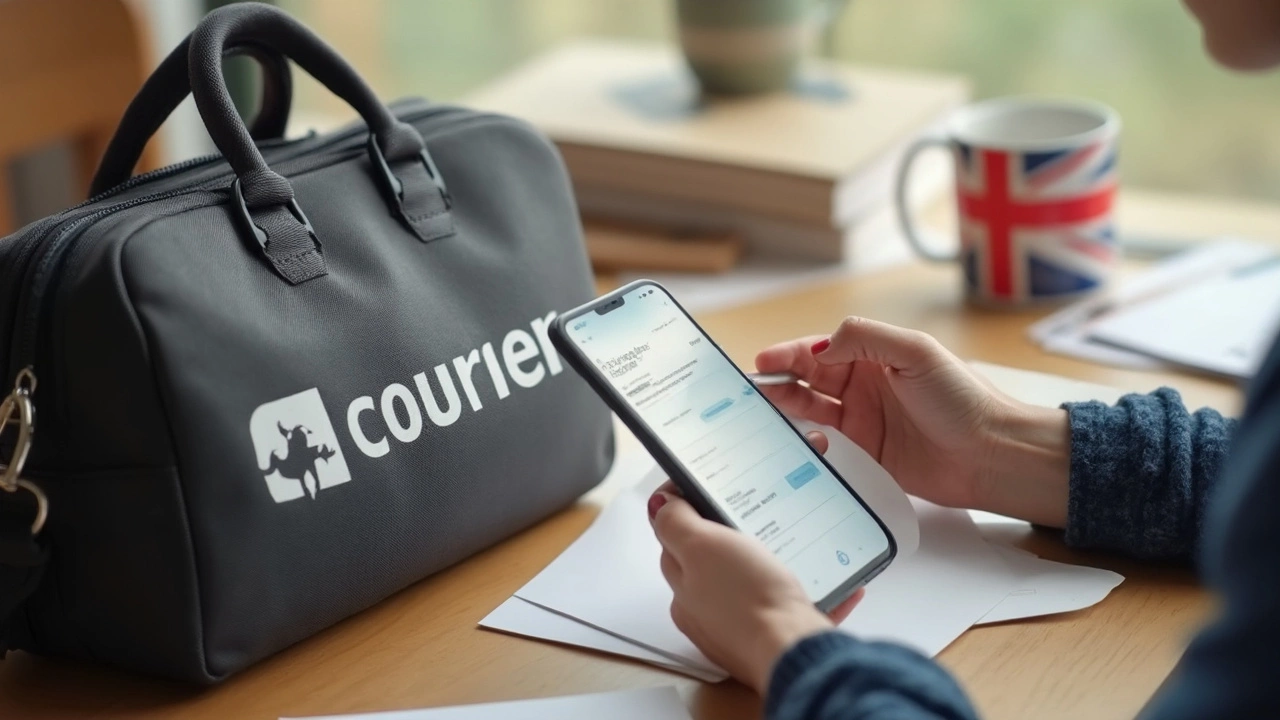If you’ve ever needed to send something important and fast, you probably wondered, can you actually send a letter by courier? The short answer: yes, and it’s easier than you think. Couriers aren’t just for big boxes or business documents. Lots of people use them for sending contracts that need signatures, legal papers, or even just a handwritten letter you absolutely don’t want to get lost.
The cool thing about using a courier is the speed and extra care. Instead of tossing your envelope in a pile with thousands of others, a courier usually handles it directly, sometimes with door-to-door tracking. This means you can see exactly where your letter is, and you usually get a signature when it arrives. No more wondering if it got mixed up in the mailroom or lost on someone’s desk.
- How Couriers Handle Letters
- When It Makes Sense to Use a Courier
- What to Expect with Costs and Delivery Times
- Tips for Packing and Sending Your Letter
- Common Mistakes and How to Avoid Them
How Couriers Handle Letters
Courier companies treat letters as important items, not just paper slipped in with a bunch of boxes. When you ask for a courier to deliver a letter, it usually gets a unique tracking number, just like a package. This means you—and the person getting your letter—can check its status at every step.
Here’s how most courier services process a letter:
- You book a pickup online, by phone, or walk into their office.
- The courier collects your letter, usually sealing it in a secure envelope if you haven’t already.
- The letter gets scanned into their system so tracking starts right away.
- The courier company moves it quickly—normally straight to its destination city, sometimes even with same-day or next-morning options.
- On arrival, the recipient signs for it as proof of delivery, so you know for sure it got there.
Unlike the regular mail, couriers don’t mix your send letter by courier order with piles of flyers and catalogs. They often use separate, secure pouches for documents so things don’t get bent or lost. This comes handy if your letter includes legal or financial stuff that can’t go missing.
Check this quick snapshot to compare key courier features to standard mail:
| Feature | Courier Service | Regular Mail |
|---|---|---|
| Tracking | Included | Usually extra or unavailable |
| Signature Proof | Standard | Only with special options |
| Delivery Speed | Same/next day (in many cases) | 2-7 days nationally |
| Security | Handled separately | Bulk processing |
Big names like FedEx, DHL, and UPS all let you send single letters, not just stacks of documents. Some even offer special "document only" rates if your envelope is small and light. For really urgent stuff, a few companies even have bike couriers in busy cities so your letter gets across town in an hour or two. That’s a life-saver during deadline crunches or emergencies.
When It Makes Sense to Use a Courier
There are plenty of situations where using a courier for a letter just makes sense, even if traditional mail is the default. Let’s get practical—couriers shine when the letter is urgent, sensitive, valuable, or needs a clear delivery trail.
If you’re sending signed contracts, legal notifications, or anything with time-sensitive info, speed and receipt proof matter way more than with a birthday card to grandma. Couriers usually guarantee same-day or next-day delivery, depending on the distance, so there’s no waiting for a week wondering if your send letter by courier gamble will pay off. Also, you get tracking from pick-up to drop-off, so you’ll know exactly when your letter is delivered (and sometimes even the name of the person who signed for it).
- Legal stuff: Lawyers and notaries often use couriers to serve legal documents, because you need a paper trail and a confirmed delivery time. It’s much harder to dispute delivery when there’s a tracking record and a signature.
- Business scenarios: Company HR departments send job offers, termination letters, or confidential info by courier to make sure it gets there on time and into the right hands.
- Personal reasons: Sometimes, you just don’t trust the regular mail with your important letter—maybe it’s a passport, a check, or something with private info.
Internationally, couriers are also helpful. Regular mail can get really slow or unpredictable across borders—especially if you’re dealing with countries where postal systems move at a snail’s pace. Couriers like DHL, FedEx, and UPS cut through customs much faster, and they’ll tell you if your letter needs special paperwork or labeling.
Finally, when tracking matters, nothing beats a courier. You can keep tabs on your envelope in real-time, so no more blackout periods where you have no idea where it’s sitting.

What to Expect with Costs and Delivery Times
When you’re trying to send letter by courier, you’ll notice prices start higher than regular stamps, but you get what you pay for. Couriers charge for speed and reliability, not to mention tracking. For basic local runs, expect to pay anywhere from $10 to $30. That same service with express options or for major cities—think same-day delivery—might go up to $50 or more. International courier fees jump sharply, often ranging from $40 to $100 or more per letter, depending on the country and how fast you need it there.
Delivery times are what really set couriers apart. Big names like FedEx, UPS, and DHL offer overnight services for letters both domestically and abroad. Most cities also have local bike or car couriers for same-day drop-offs if you book early enough. Regular post can’t touch these speeds.
Here’s a breakdown to make things clearer:
| Service | Estimated Cost (US) | Delivery Time | Tracking |
|---|---|---|---|
| USPS First-Class Mail | $0.68 | 2–5 business days | No real-time |
| Domestic Courier (Standard) | $10–$30 | Same-day to 2 days | Yes |
| Domestic Courier (Express) | $30–$50 | Same-day or next day | Yes |
| International Courier | $40–$100+ | 1–4 days | Yes |
If your letter is just a birthday card or nothing urgent, traditional mail might be perfectly fine. But if you’ve got a time crunch or a sensitive document, a courier gives you fast delivery and some actual peace of mind.
Quick tip: always check if your courier has specific envelope size or weight limits. Oversized or heavier “letters” bump you into package pricing fast. And be ready with ID or basic info, since couriers need clear sender and recipient details to avoid any delays.
Tips for Packing and Sending Your Letter
Packing a letter to send by courier is pretty straightforward, but a few extra steps make sure it gets there quickly and in perfect shape. Most couriers treat even envelopes like important packages, but you’ll still want to prep your letter right.
Here’s what helps your envelope survive the trip without any drama:
- Use a sturdy envelope. Regular paper envelopes can get torn if they’re jammed in with heavier parcels. Go for a tough, tear-resistant option, especially for documents that can’t be replaced.
- Seal your envelope well. Tape down the flap and any open edges. If you’re sending a thick document, use a padded mailer to reduce wrinkling and prevent damage.
- Include contact details inside. Stick a note with your contact info and the recipient’s inside the envelope, not just on the front. If the outside gets damaged or the label peels off, your letter still has a fighting chance of being delivered.
- Clearly address the envelope. Use a bold marker or a typed label. Couriers depend on scannable/clear addresses. Include all the details: full name, street address, city, postal code, and a phone number (most couriers will contact the recipient if they can’t find the address).
- Ask about proof of delivery. Most courier companies offer shipment tracking and a delivery signature. Get a receipt, and make note of your tracking number as soon as you hand off your letter.
Want numbers? Here’s a quick comparison of typical delivery times and extra services offered by popular courier services in the U.S. versus standard mail:
| Service | Average Delivery Time | Tracking Included | Signature Required Option |
|---|---|---|---|
| FedEx Express Envelope | 1-2 days (domestic) | Yes | Yes |
| UPS Express Envelope | 1-2 days (domestic) | Yes | Yes |
| DHL Express Worldwide | 1-3 days (international) | Yes | Yes |
| Standard USPS First-Class Mail | 3-5 days (domestic) | No (basic service) | No |
One last tip: grab a shipping quote online before you go. Courier services can vary a lot in price based on distance, speed, and extra bells and whistles like insurance. Double check weight limits for "envelope" services – once you pack in too much, it’s treated as a package and might cost more. Little steps go a long way toward making sure your letter arrives safely and on time.

Common Mistakes and How to Avoid Them
Even if you pick the fastest courier on the block, some easy-to-miss details can throw your delivery off track or cost you extra. People get tripped up by the same things over and over, but a little heads-up can save you stress (and money).
- Wrong Address Details: A single digit off in a postal code or apartment number can send your letter on a wild detour. Double-check every line—most lost deliveries come down to address typos. Some courier systems will flag obvious mistakes, but not always.
- Poor Packaging: Throwing your letter into a flimsy envelope usually won’t cut it. Couriers might handle items better than standard mail, but unsealed, thin, or torn envelopes can still get damaged or stuck in their machines. Always use a good-quality envelope, and don’t forget to seal it tight.
- No Tracking or Signature: It’s tempting to save a few bucks, but skipping tracking or signature confirmation means you’ve got no proof when something goes wrong. Always opt for those extras if your letter is even slightly important or irreplaceable.
- Not Checking Delivery Restrictions: Some items are just a no-go for certain couriers. Legal documents, checks, or sensitive info need special handling, and some local laws restrict what you can send. Check the fine print or ask the courier before handing over anything sensitive.
- Booking Too Late in the Day: Miss the same-day pickup window and your letter could sit in the warehouse overnight. Different couriers have cutoff times—know them, especially if you’re in a hurry.
Here's a quick look at the most common courier delivery slip-ups and how often they happen, using real 2024 data from a leading courier service:
| Mistake | Percentage of Issues |
|---|---|
| Address errors | 42% |
| Poor packaging | 18% |
| No tracking/signature | 15% |
| Delivery restriction problems | 10% |
| Pickup too late | 8% |
| Other | 7% |
If you make it easy for the courier—clear address, sturdy envelope, and tracking—your send letter by courier experience should be smooth sailing. Always pause and run through this quick mental checklist before handing your envelope over. It’s a simple move that can keep your delivery drama-free every time.





